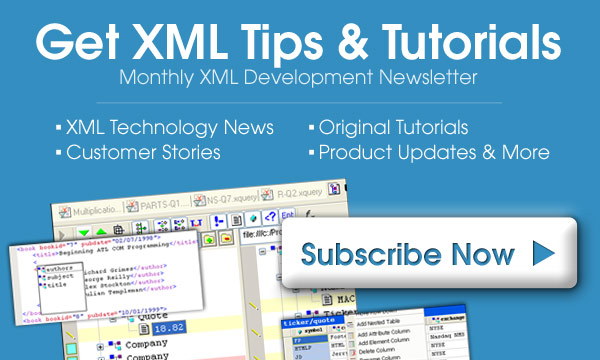|
[XSL-LIST Mailing List Archive Home] [By Thread] [By Date] [Recent Entries] [Reply To This Message] RE: XSLT/XPath 2.0: a USEFUL way to provide lexical in
From: "Michael Kay" <michael.h.kay@xxxxxxxxxxxx> Reply-To: xsl-list@xxxxxxxxxxxxxxxxxxxxxx To: <xsl-list@xxxxxxxxxxxxxxxxxxxxxx> Subject: RE: XSLT/XPath 2.0: a USEFUL way to provide lexical info Date: Sun, 6 Jan 2002 20:01:00 -0000 Maybe I'm misunderstanding you, but I think the solution I was proposing is fairly straight-forward: preserve the same data model as in Appendix F of the 2001-12-20 XSLT 2.0 WD, but simply add an axis pair for hopping between two different trees--one which has the elements corresponding to lexical constructs, and the traditional one. If you're already in the lexical tree, then the 'lexical-tree' axis does nothing, however the 'structural-tree' axis would take you back to a traditional view of the document. Also, if a processor doesn't support this feature then both axes would do nothing. For example, copying a tree fragment from the lexical tree should preserve the entity references. I don't know whether you want to force the user to also manually create the entity definitions, in the result tree, or just have the processor be smart about copying definitions for which there are references. Either is usable, and I imagine that when users are concerned about preserving entity references, they will simply copy all the entity definitions into the result tree. Jeni is right that this would more than double the memory required to parse a document. But so what? Make it optional, and maybe processors will provide a switch to enable support for it, so you don't incur the overhead when you don't need lexical info. Matt Gruenke _________________________________________________________________ Join the world?s largest e-mail service with MSN Hotmail. http://www.hotmail.com XSL-List info and archive: http://www.mulberrytech.com/xsl/xsl-list
|
PURCHASE STYLUS STUDIO ONLINE TODAY!Purchasing Stylus Studio from our online shop is Easy, Secure and Value Priced! Download The World's Best XML IDE!Accelerate XML development with our award-winning XML IDE - Download a free trial today! Subscribe in XML format
|

 Cart
Cart








